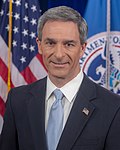| No. | Portrait | Director | Took office | Left office | Time in office | Party | President |
|---|
| 1 | | Aguirre, Eduardo Eduardo Aguirre
(born 1946) | August 15, 2003 | June 16, 2005 | 1 year, 305 days | Republican | Bush, George George W. Bush (R) |
| – | | Petrucelli, Michael Michael Petrucelli
Acting | June 17, 2005 | July 25, 2005 | 38 days | ? | Bush, George George W. Bush (R) |
| 2 | | Gonzalez, Emilio Emilio T. Gonzalez
(born 1956) | December 21, 2005 | April 18, 2008 | 2 years, 119 days | Republican | Bush, George George W. Bush (R) |
| – | | Scharfen, JonathanJonathan "Jock" Scharfen
Acting | April 21, 2008 | December 2, 2008 | 225 days | ? | Bush, George George W. Bush (R) |
| 3 | | Mayorkas, Alejandro Alejandro Mayorkas
(born 1959) | August 12, 2009 | December 23, 2013 | 4 years, 133 days | Democratic | Obama, Barack Barack Obama (D) |
| – | | Scialabba, LoriLori Scialabba
Acting | December 23, 2013 | July 9, 2014 | 198 days | ? | Obama, Barack Barack Obama (D) |
| 4 | | Winkowski, Thomas León Rodríguez
(born 1962) | July 9, 2014 | January 20, 2017 | 2 years, 195 days | Democratic | Obama, Barack Barack Obama (D) |
| – | | Scialabba, LoriLori Scialabba
Acting | January 20, 2017 | March 31, 2017 | 70 days | ? | Trump, Donald Donald Trump (R) |
| – | | McCament, JamesJames W. McCament
Acting | March 31, 2017 | October 8, 2017 | 191 days | ? | Trump, Donald Donald Trump (R) |
| 5 | | Cissna, Lee L. Francis Cissna
(born 1966) | October 8, 2017 | June 1, 2019 | 1 year, 236 days | Independent | Trump, Donald Donald Trump (R) |
| – | | Koumas, MarkMark Koumans
Acting | June 1, 2019 | June 10, 2019 | 9 days | Independent | Trump, Donald Donald Trump (R) |
| – | | Cuccinelli Ken Cuccinelli [1]
(born 1968)
Acting | June 10, 2019 | November 18, 2019 | 161 days | Republican | Trump, Donald Donald Trump (R) |
| – | | Koumas, MarkMark Koumans
Acting | November 18, 2019 | February 20, 2020 | 94 days | Independent | Trump, Donald Donald Trump (R) |
| – | | Edlow, Joseph Joseph Edlow
(born 1981)
Acting | February 20, 2020 | January 20, 2021 | 335 days | Independent | Trump, Donald Donald Trump (R) |
| – | | Renaud, TraceyTracy Renaud
Acting | January 20, 2021 | August 3, 2021 | 195 days | Independent | Biden, Joe Joe Biden (D) |
| 6 | | Mendoza, Ur Ur Mendoza Jaddou
(born 1974) | August 3, 2021 | January 20, 2025 | 3 years, 170 days | Independent | Biden, Joe Joe Biden (D) |
| – | | Higgins, Jennifer B. Jennifer B. Higgins
Acting | January 20, 2025 | February 9, 2025 | 20 days | ? | Trump, Donald Donald Trump (R) |
| – | | Scott, KikaKika Scott
Acting | February 9, 2025 | May 25, 2025 | 105 days | ? | Trump, Donald Donald Trump (R) |
| – | | Alfonso-Royals, AngelicaAngelica Alfonso-Royals
Acting | May 25, 2025 | July 18, 2025 | 54 days | ? | Trump, Donald Donald Trump (R) |
| 7 | | Edlow, Joseph Joseph Edlow
(born 1981) | July 18, 2025 | Incumbent | 149 days | Independent | Trump, Donald Donald Trump (R) |


















